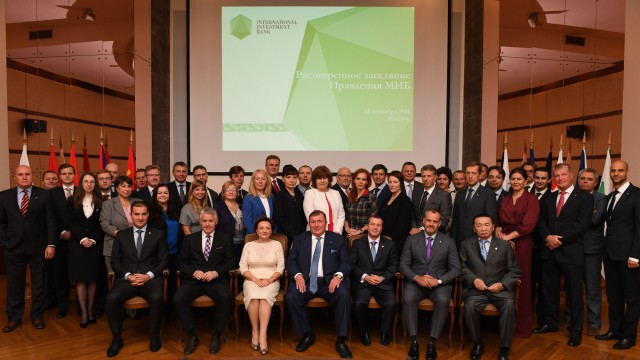Interim results for 2016 confirm IIB’s financial stability and give impulse to complete the year with steady growth

Interim results of the main divisions of the International Investment Bank (IIB) for the first eight months of 2016 confirm the Bank's financial stability and give positive impulse for completing the year with steady growth. This was the main conclusion of the extended meeting of the IIB Board, held on September 15, 2016 at the Bank’s headquarters. The special feature of the event was that participation was not restricted to Board members, directors of departments and representatives of the IIB European Regional Office (ERO) in Bratislava, but, in fact, all staff could take part through live streaming of the meeting.
This year, the IIB continued qualitative strengthening of its loan operations and the formation of a pool of high-grade borrowers. It became possible due to projects such as the co-financing with the Black Sea Trade and Development Bank of a syndicated EUR 50m loan to the Tyras, promising project of hydropower plant construction in Russia’s Republic of Karelia jointly with the BRICS’ New Development Bank and the Eurasian Development Bank, and a syndicated USD 125.5m facility for Mongolia’s XacBank with the IFC and the Dutch FMO.
The IIB continued its active management approach to operations on the securities market. In June, as part of assets diversification, the institution started forming a new, high-quality portfolio of securities – “MDBs portfolio”, which includes issuers with high investment grade ratings and similar organisational structure to that of the IIB.
Demand for the Bank’s trade finance (TF) operations remained strong – since the beginning of the year, 14 transactions took place, totalling EUR 9.7m, including the first TF deal with Cuban partners.
The rating agency S&P took note of the sound financial position of the IIB in June. The Bank was assigned a long-term rating of BBB, together with a short-term rating of A-2, both with stable outlook, which creates additional opportunities on the capital markets.
Issues of strategic and institutional development of the Bank were at the centre of the meeting. Chairman of the IIB Board, Nikolay Kosov, emphasized the need to finish on time the implementation of the corporate governance reform and the preparation of a new long-term development strategy of the institution for the period up to 2022.
N. Kosov noted that IIB’s experience of interacting with international rating agencies and establishing solid IT-infrastructure is of interest to other IFIs, including the BRICS’ NDB. “We have started to provide consultancy services to MDBs in areas where we have rapidly built from scratch processes that meet the highest standards," – he stressed.
Speaking about plans, Chairman of the Board said that the macroeconomic situation obliges the Bank to strengthen relations with its clients and carefully build long-term partnerships with them. Focused attention should be paid to consistent increase of the volume of operations in the member states, in order to avoid recessions in performance of the institution, and the ERO in Bratislava should play a special role in this process.
“Stabilisation of lending activity and diversification of operations – these are the main priorities for the IIB in the coming period, which will allow us to finish the year with good dynamics in order to achieve a new level of operational efficiency and to meet targets aimed at developing our shareholders’ economies,” – summarized N. Kosov. Meeting these plans, the IIB will join the number of sustainable international financial institutions – even more importantly, it will prepare the Bank for the new strategic cycle and a qualitatively new level od development.
During the meeting, Maxim Bychkov, new Director of IIB’s Strategic Development and Analysis Department, was presented to participants. His area of responsibility will include the assessment of the impacts of the macroeconomic environment on the operations of the Bank, as well as the implementation of the strategic planning process.
